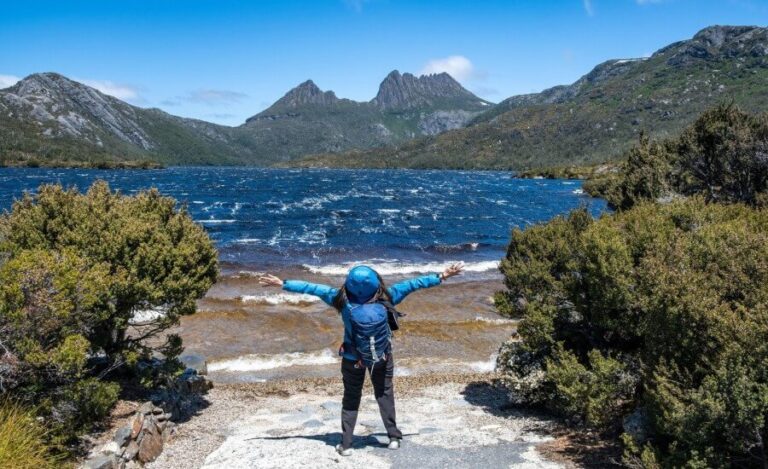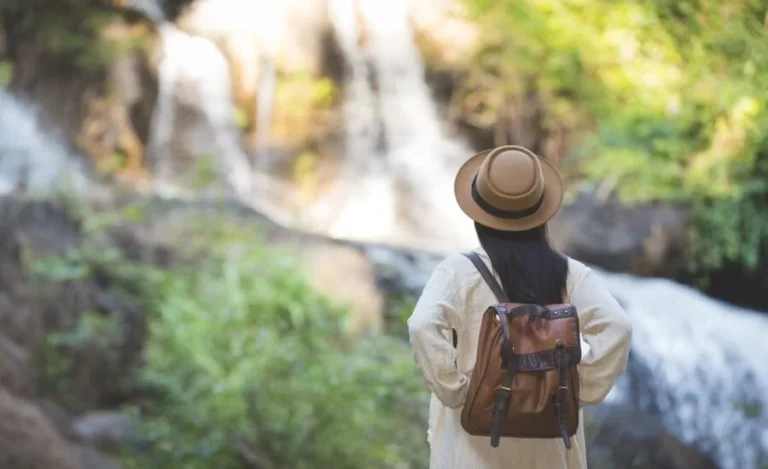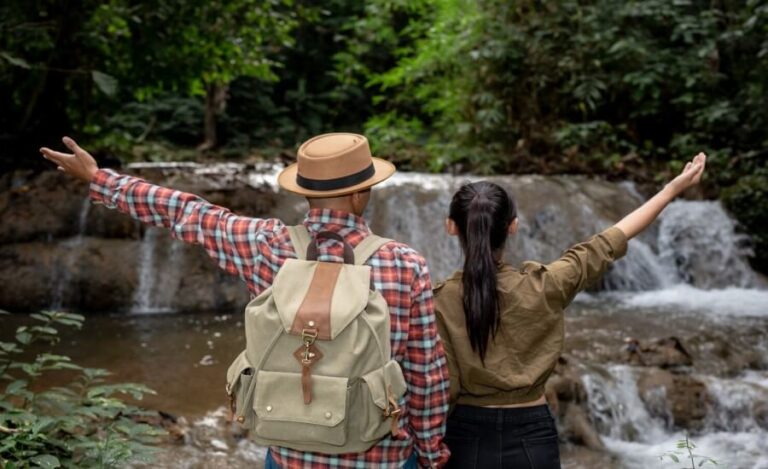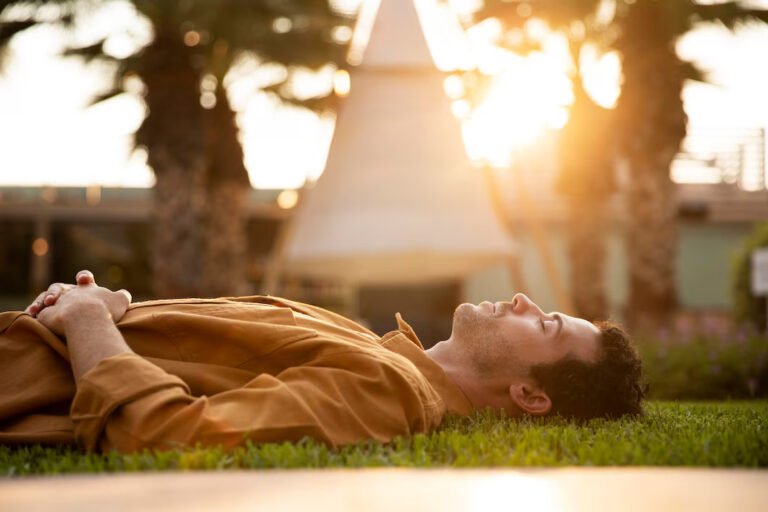
The sky erupts in a dance of green and purple waves, casting an otherworldly glow across the snow-covered landscape. There’s a collective gasp from the small group of travelers standing in reverent silence. Not a single phone has been raised to capture the moment instead, five pairs of eyes are wide with wonder, fully present for nature’s most spectacular light show.
This scene, increasingly rare in our Instagram-obsessed travel culture, represents a profound truth: the Northern Lights are among the few natural phenomena that defy digital reproduction. No photo or video can truly capture their ethereal movement, the way they pulse and flow across the night sky, or how they make you feel standing beneath their luminous dance.
For budget travelers willing to disconnect from technology and connect more deeply with this extraordinary experience, the Aurora Borealis becomes not just a bucket-list sight, but a soul-stirring journey that costs far less than you might imagine.
The Mythical Aurora: Understanding Nature’s Light Show
Before planning your budget-friendly Northern Lights adventure, understanding the science behind this phenomenon helps maximize your chances of witnessing it without expensive guided tours or apps.
The Northern Lights occur when solar particles collide with gases in Earth’s atmosphere, creating luminous displays typically visible in high-latitude regions near the Arctic Circle. This natural process follows solar cycles and seasonal patterns that savvy budget travelers can leverage.
When Science Meets Budget Planning
The Aurora’s visibility depends on several factors that cost-conscious travelers should consider:
- Solar activity cycles: The sun goes through roughly 11-year cycles of activity. During solar maximum periods, auroral displays are more frequent and intense, potentially visible at lower latitudes. This means you might see them without traveling as far north, saving significantly on transportation costs.
- Seasonal darkness: The lights are actually occurring year-round, but you need dark skies to see them. Winter months (September-March in the Northern Hemisphere) offer the longest nights and best viewing opportunities.
- Lunar phases: A new moon or crescent moon phase provides darker skies than a full moon, improving visibility without requiring expensive tours to remote locations.
Understanding these patterns allows budget travelers to plan trips during optimal viewing periods rather than paying premium prices for guided “aurora hunting” excursions that use technology to predict sightings.
Have you considered how our ancestors tracked and predicted the Northern Lights without smartphones or forecasting websites? Their deep knowledge of seasonal patterns and sky conditions often exceeded our technology-dependent understanding today.
Unplugging to See the Lights: Why Tech-Free Aurora Viewing Enhances the Experience
“I spent three hours trying to photograph the Northern Lights during my first sighting,” admits Tomas, a budget traveler from Spain. “When I got home, I realized I had barely seen them with my own eyes. My second trip, I left my phone behind completely. The difference was profound—I actually remember the experience instead of just having photos of it.”
When we disconnect from technology while viewing the Northern Lights, several transformative shifts occur:
Enhanced Night Vision
Digital screens emit blue light that impairs night vision. It takes approximately 20-45 minutes for human eyes to fully adapt to darkness, allowing us to see the more subtle displays of the Aurora. Every glance at a phone screen resets this adaptation process.
Without the distraction of devices, your eyes naturally adjust to detect even faint auroral activity that many technology-focused viewers miss entirely—giving budget travelers an advantage over those who paid for expensive tours but remain glued to their screens.
Deeper Sensory Engagement
The Northern Lights are a multi-sensory phenomenon. Some displays create faint sounds described as crackling or swishing. In extreme cold, the aurora sometimes accompanies unique atmospheric effects like light pillars or diamond dust.
These subtle experiences are completely missed when attention is fragmented by technology. By fully engaging your senses, you’ll experience dimensions of the Aurora that no digital reproduction can capture.
Meaningful Human Connection
Budget travel often involves shared accommodations or transportation. These shared experiences around the Aurora create lasting human connections that many travelers describe as equally valuable as the lights themselves.
When everyone in a group is present rather than documenting, spontaneous conversations emerge, cultural stories are shared, and the collective wonder amplifies the experience in ways no social media post can replicate.
Affordable Aurora Destinations: Where Budget Meets Brilliance
Contrary to popular belief, experiencing the Northern Lights doesn’t require expensive trips to premium destinations like Finnish glass igloos or luxury Icelandic resorts. These alternatives offer excellent aurora viewing at fraction of the cost:
Abisko, Sweden
This small village in Swedish Lapland sits in what meteorologists call a “blue hole”—a microclimate that creates unusually clear skies regardless of surrounding weather patterns. This natural advantage gives budget travelers higher viewing chances without expensive tours or technology.
Budget-Friendly Aspects:
- The Swedish Allemannsrätten (Right to Roam) law allows free camping in many areas
- Abisko Mountain Station offers affordable dormitory accommodations
- The local train station provides direct access without requiring car rentals
- The surrounding national park offers free entry and multiple ideal viewing locations
Tromsø, Norway
Though Norway has a reputation for being expensive, Tromsø offers budget travelers strategic advantages for aurora viewing:
Budget-Friendly Aspects:
- Extensive public transportation reduces the need for costly tours
- University town atmosphere means affordable eateries and hostels
- Surrounded by easily accessible mountains offering unobstructed views
- Public libraries and community centers often post aurora forecasts for free
Fairbanks, Alaska
For North American travelers, flying to Scandinavia might exceed budget constraints. Fairbanks offers a domestic alternative with exceptional aurora statistics:
Budget-Friendly Aspects:
- Positioned under the “aurora oval” where activity is most concentrated
- University of Alaska offers free aurora forecasts and public viewing areas
- Winter camping permits are affordable for the truly budget-conscious
- Local community aurora watch groups welcome visitors and share viewing spots without charge
Whitehorse, Yukon, Canada
This accessible Canadian destination combines good infrastructure with relatively lower costs:
Budget-Friendly Aspects:
- Less international tourism pressure keeps prices moderate
- Municipal parks outside town offer excellent free viewing platforms
- Seasonal work opportunities can offset travel costs for longer stays
- Indigenous cultural centers offer traditional aurora knowledge without expensive tourist markups
Timing is Everything: Strategic Scheduling for Budget Aurora Travel
Strategic timing can reduce costs by 40-60% while potentially improving your chances of successful aurora viewing:
Shoulder Season Advantages
While December-February offers peak darkness, prices soar during these months. Consider these alternatives:
- Late September-October: Early aurora season coincides with post-summer price drops at many northern destinations. Fall colors provide spectacular foreground for aurora photography without requiring expensive lenses.
- March-Early April: Longer days provide more daytime activities while nights remain dark enough for aurora viewing. Many accommodations and flights drop prices significantly after the winter high season.
Weekday Wisdom
Weekend aurora tours and accommodations often command premium prices. By planning your viewing attempts for weeknights, you’ll find:
- Lower accommodation rates (often 20-30% less)
- Fewer crowds at popular viewing locations
- More availability at hostels and budget guesthouses
- Reduced rates for any necessary transportation
Long-Stay Strategy
For maximum aurora opportunities on minimum budgets, consider longer stays during optimal periods:
- Monthly apartment rentals often cost less than two weeks in hotels
- Cooking facilities reduce expensive restaurant meals
- Local transportation passes become more economical
- Multiple viewing nights increase success chances without expensive tours
Many budget travelers report that this slow-travel approach not only saves money but creates deeper, more meaningful experiences in aurora destinations.
The Art of Disconnecting: Practical Strategies for Tech-Free Aurora Viewing
Freeing yourself from technology dependency while aurora hunting requires thoughtful preparation and alternative approaches:
Navigation Without GPS
Finding dark sky locations without technology might seem challenging, but these alternatives work remarkably well:
- Paper maps and compass: Learn to identify major constellations as navigational anchors. The North Star (Polaris) provides reliable orientation in all northern aurora viewing locations.
- Community bulletin boards: Local libraries, hostels, and community centers often post paper maps marking optimal aurora viewing sites.
- Daytime scouting: Visit potential viewing locations during daylight hours to familiarize yourself with the terrain and access routes.
- Local knowledge: Engage with residents who can provide hand-drawn maps or simple directions to local viewing spots that may not appear on tourist materials.
Many travelers report that navigation without GPS creates a deeper connection to landscapes and often leads to discovering secluded viewing spots overlooked by tour groups.
Aurora Prediction Without Apps
While aurora forecast apps seem indispensable, traditional methods offer reliable alternatives:
- Local radio reports: Many northern communities include aurora forecasts in weather reports.
- Cloud observation skills: Learning basic cloud pattern recognition helps identify nights with clear sky potential.
- Kp index charts: Public buildings in aurora regions often post paper Kp index forecasts (measuring geomagnetic activity) that you can check during the day.
- Sun cycle awareness: Track solar activity through community bulletin boards where scientific organizations often post recent solar event information.
Capturing Memories Without Smartphones
The impulse to document the Northern Lights is understandable, but consider these alternatives:
- Mental photography techniques: Practice observation methods that enhance memory formation—verbally describing what you see, associating colors with emotions, counting wave sequences.
- Field sketching: Even basic drawing skills can create deeply personal aurora records. Quick color sketches with notes about movement patterns create meaningful souvenirs.
- Disposable cameras: For those who still want photographs, simple film cameras capture surprisingly effective aurora images without the light pollution or distraction of digital screens.
- Collaborative documentation: If traveling with companions, designate one person as “recorder” each night while others fully immerse in the experience, then rotate this role throughout your trip.
The most precious souvenirs from aurora experiences are rarely the digital images but the embodied memories—how the lights moved, how you felt watching them, who you shared the moment with, and what insights emerged in their ethereal presence.
Mindful Engagement: Practices for Deepening Aurora Connection
Disconnecting from technology creates space for deeper aurora experiences. These practices help maximize the potential of your budget-friendly viewing:
The 15-Minute Patience Practice
Aurora viewing rewards patience. Develop this skill through intentional practice:
- Upon arriving at your viewing location, set a mental timer for 15 minutes
- Commit to complete sensory presence during this time—no conversation, no movement
- Observe the entire sky systematically, not just the northern horizon
- Notice how your perception changes as your eyes adapt to darkness
- Repeat this practice hourly throughout your viewing session
This patience practice helps you detect subtle auroral activity that impatient viewers miss entirely, maximizing the value of your budget travel investment.
Cold Immersion Meditation
Aurora viewing often involves standing in cold temperatures for extended periods. Transform this challenge into a mindfulness practice:
- Focus attention on the sensation of cold without judgment
- Notice how your body responds and adapts to the temperature
- Practice rhythmic breathing to generate internal warmth
- Alternate between focused attention on the sky and awareness of your body’s experience
This practice not only enhances aurora viewing but eliminates the need for expensive heated viewing pods or vehicles that separate you from the complete experience.
Sound Awareness
While the visual display captures most attention, the complete aurora experience includes subtle soundscapes:
- Cup hands behind ears to amplify environmental sounds
- Listen for the rare crackling sometimes associated with intense aurora activity
- Notice how snow absorbs or reflects sound in the landscape
- Perceive how silence itself becomes a presence during the display
This auditory dimension of aurora viewing costs nothing yet adds immeasurable richness to the experience that many technology-focused viewers completely miss.
Common Concerns & Solutions for Tech-Free Aurora Travel
“How will I know when the aurora is happening without alert apps?”
Solution: Develop the habit of regular sky checking. The Northern Lights often begin subtly and build in intensity. By stepping outside for 5-minute sky checks every hour during evening hours, you’ll catch developing displays without technology. Additionally, in aurora-prone regions, a local phenomenon occurs—people often step outside simultaneously when displays begin, creating a noticeable community movement that serves as a human alert system.
“What if I get lost in remote viewing locations without GPS?”
Solution: Practice safe exploration techniques. Always scout locations during daylight hours. Use the buddy system when venturing beyond settled areas. Learn basic celestial navigation using Polaris (the North Star) which is always visible in aurora viewing latitudes. Carry a whistle and small compass as backup safety tools. Remember that northern communities have navigated these regions for centuries before digital technology.
“How will I share my experience with friends and family?”
Solution: Embrace the art of storytelling. Throughout human history, travelers returned with tales rather than images. Practice mindful observation during your experience, noting specific details, sequences, and sensations. Journal about your viewing experiences each morning while memories remain fresh. Your rich, firsthand account will likely prove more compelling than digital images that fail to capture the aurora’s true essence.
“What if I miss a spectacular display because I didn’t check a forecast?”
Solution: Aurora activity follows patterns that can be tracked without real-time digital tools. Learn to recognize increased solar activity signs (visible sunspots have been tracked since ancient times). Check paper forecasts posted in public locations during the day. Understand that the most spectacular displays often follow solar events by 2-3 days. Most importantly, recognize that consistent viewing over multiple nights—possible on a budget trip—increases your chances more effectively than technology dependence.
Before You Go: The Tech-Free Aurora Travel Preparation Checklist
Essential Preparations:
- Research your destination thoroughly before departure (print relevant information)
- Purchase appropriate physical maps with topographical features and compass
- Acquire a reliable watch with illumination that preserves night vision (red light)
- Pack appropriate extreme cold weather gear (layers, insulation, windproofing)
- Bring a red-light headlamp that preserves night vision
- Prepare a thermos for hot beverages during viewing sessions
- Pack a small notebook and pencil (pens freeze in extreme cold) for aurora journaling
- Learn basic constellation identification for the season of your travel
- Research local aurora legends and cultural significance
- Practice cold-weather meditation techniques before your trip
- Prepare for technology withdrawal with mindfulness tools and practices
- Create a physical packing list organized by temperature ranges
Digital Minimalism Option:
If complete disconnection isn’t possible or advisable for safety reasons:
- Designate a single morning check of aurora forecasts, then disconnect
- Use “airplane mode” as your default device state to preserve battery in cold
- Remove social media apps and email from devices you bring
- Pre-download any essential maps for emergency use only
- Set expectations with others about your limited availability
- Keep devices in inner pockets (close to body heat) to preserve battery life
- Establish device-free viewing protocols (perhaps keeping technology in your accommodation)
Integrating the Aurora Experience: Bringing the Northern Magic Home
The true value of a budget Northern Lights experience extends far beyond the viewing moments. To preserve and build upon this unique form of unplugged travel:
Create Aurora-Inspired Practices
The darkness required for aurora viewing often resets our circadian rhythms to more natural patterns. Consider maintaining:
- Reduced artificial light exposure after sunset
- Regular stargazing practices even in urban environments
- Seasonal awareness of changing light patterns
- Comfortable relationship with darkness and night
Extract Philosophical Insights
The Northern Lights offer powerful metaphors for life challenges. Many travelers report insights about:
- The beauty that emerges from turbulence (auroras result from solar storms)
- Patience yielding unexpected rewards
- The value of experiences that cannot be digitally captured or reproduced
- Finding peace in natural rhythms beyond human control
Implement Digital Boundaries
Use your experience of disconnection to establish healthier technology boundaries in daily life:
- Designated device-free hours, especially around sunset and sunrise
- Regular “dark sky” experiences away from light pollution
- Reduced social media sharing in favor of direct experience
- Regular digital sabbaticals inspired by your aurora journey
Share Your Budget Wisdom
Perhaps the most valuable outcome is the knowledge that profound experiences don’t require premium prices or technological mediation:
- Mentor others in budget-conscious, technology-free travel
- Challenge the assumption that expensive tours provide better aurora experiences
- Share specific cost-saving strategies that enhanced rather than diminished your journey
- Emphasize the value of patience, presence, and personal preparation over purchased convenience
The Deeper Invitation: Beyond the Bucket List
Budget-friendly, technology-free Northern Lights travel offers immediate wonder, but its deeper invitation extends beyond checking an item off a bucket list. These journeys often become thresholds to more fundamental life reassessment.
In the hushed presence of this ancient celestial phenomenon, essential questions naturally arise:
What other natural wonders am I missing through digital distraction? How might patience and presence enhance everyday experiences? What could I discover if I engaged more directly with the night sky at home? How can I bring the aurora’s lessons about natural rhythms into my daily life?
The most powerful aurora experiences don’t just provide spectacular memories—they transform your relationship with natural phenomena, with technology, and with time itself. The clarity gained through unplugged aurora viewing often catalyzes changes that enhance life long after returning home.
As you contemplate your own budget-friendly journey to witness the dancing lights, remember that throughout human history, people have stood in awe beneath this spectacle without spending fortunes or viewing the experience through screens. Indigenous cultures considered aurora sightings profound gifts rather than purchasable commodities.
Your adventure awaits—not as an expensive, technology-mediated tourist activity, but as a direct encounter with one of our planet’s most extraordinary natural phenomena.
Will you accept the invitation to witness it fully present, with your own eyes, and within your budget?






